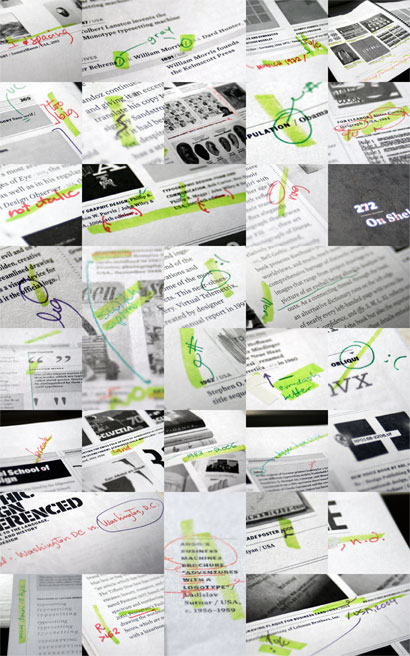It is always strange when my dreams and work life get tangled in the dark. No amount of coffee can make vector-dreaming go away, nor can it make the fears of wrapping up a project diminish. Yet, upon finishing the largest (self-imposed) assignment of my life so far, it is with terror that I place my head upon the pillow each night, wondering what might jumpstart the waking of my speeding heart. Graphic Design, Referenced is comprised of 115,000 words, 2,500 images, and a complex grid: Elements that are all wide open to minute and gargantuan mistakes. Or both. After reading the comp (text and design) cover-to-cover twice — flooding page after page in scribbles, notes, corrections and queries in various ink colors — I can’t help but wonder if we missed something. Is there an extra space somewhere? Do elements misalign? Is a date wrong? Did we triple-triple check the spelling of every name included?
A sampling of our marked-up copies of Graphic Design, Referenced. [Click on image for bigger view]
I would hate to answer Yes to any of the above, yet I know that once the book is printed and I sit down to read it once more I am going to scream-kick-groan-and-possibly-punch as I find the little details that evaded me before. How is it possible that two authors/designers, and their team of editor, proofreader, fact-checker, production manager, etc. miss these things? Part human error, part optical illusion, part exhaustion, part phone ringing in the middle of a sentence, part fear… So much is incorporated into each page that when you multiply it times 400 (pages) it is understandable that something be overlooked, yet I find it very hard to accept the presence of a typo. It has happened before, on smaller projects such as a brochure, a poster, a website, even in our two previous books (The Word It Book and Women of Design), and each time I curse the day we sent the files out the door, typo(s) included, with an oblivious FedEx driver as he drives into the sunset.
So what is the solution? It escapes me. But this experience has made me more understanding of the mistakes and incongruent texts I found in other books during our research. I am more tolerant of mistakes and I wish I could call or email each author noting my findings — hoping for a second edition for all, a chance to correct those typos that only a printed piece can reveal.
In the meantime I will have to keep my mind occupied and distracted with a new task, so as not to obsess too much as I wait for the bound book to touch the palm of my hand and reveal to me its flaws.







Congratulations on the completion of this massive undertaking. I wish you luck with it.
Now, I hope that this doesn't cause you to have to spellcheck one last time, as this is not really a typo as such, but in this post you wrote '…is compromised of…'. This should be '…is comprised of…'. Please correct me if I'm wrong.
On Feb.18.2009 at 10:35 AM